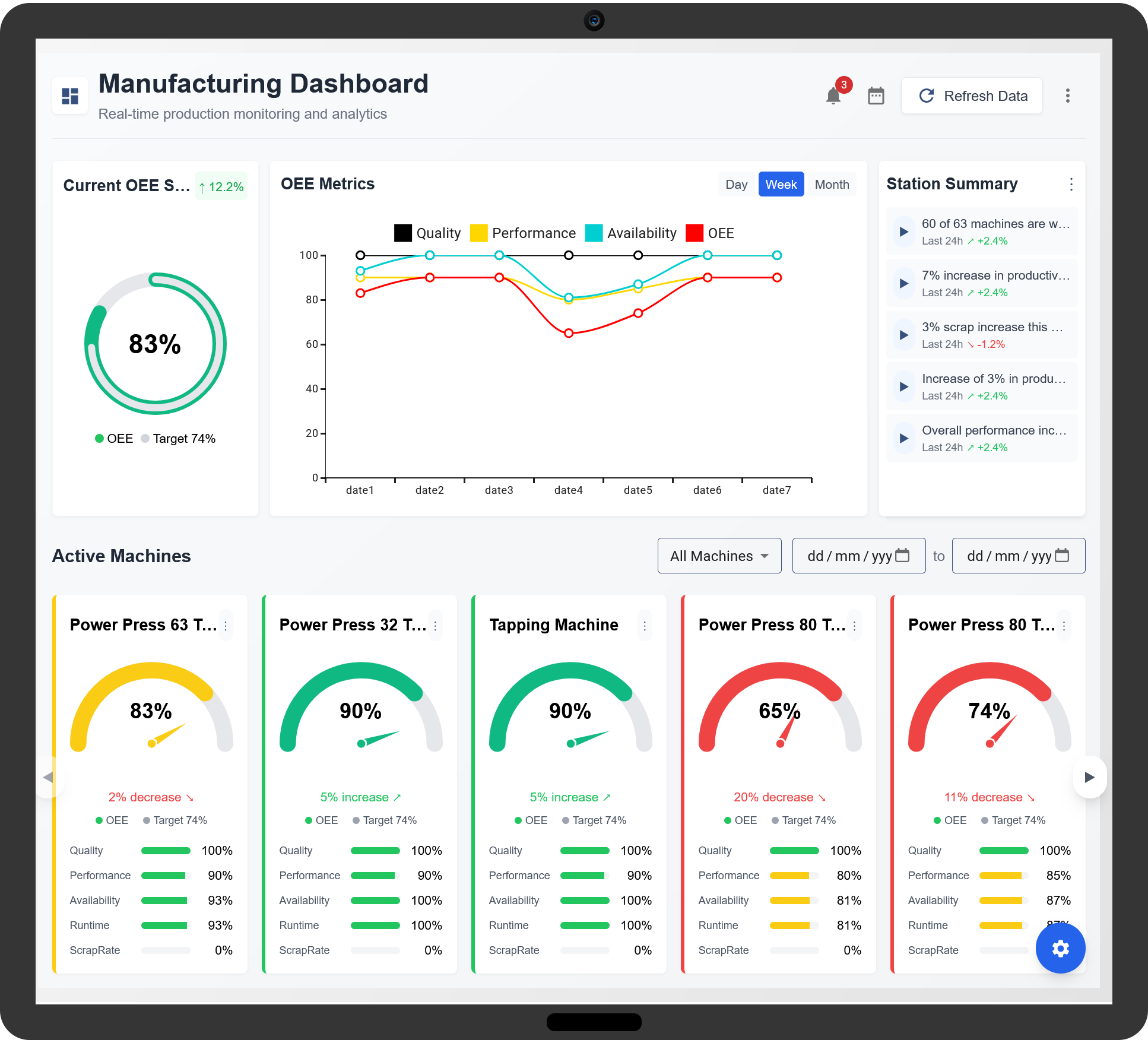Overall Equipment Effectiveness (OEE) is a vital metric used in manufacturing to assess and enhance production efficiency. By improving OEE, manufacturers can optimize their processes, reduce waste, and increase overall productivity. The three key components of OEE—Availability, Performance, and Quality—must be continuously monitored and optimized to achieve operational excellence.

1. Understanding OEE and Its Impact
- Availability: Measures the time equipment is operational versus planned production time, accounting for both scheduled and unscheduled downtimes.
- Performance: Evaluates how efficiently equipment runs compared to its maximum possible speed.
- Quality: Assesses the proportion of good units produced compared to total units manufactured.
OEE is calculated as:
OEE = Availability × Performance × Quality
Improving each of these factors contributes to higher overall efficiency, minimizing production losses.
2. Key Strategies to Improve OEE
- Reduce Equipment Downtime: Implement predictive and preventive maintenance programs to minimize unexpected breakdowns.
- Optimize Production Schedules: Ensure efficient job sequencing and reduce setup times to increase machine utilization.
- Enhance Workforce Training: Train operators on best practices to improve machine handling and reduce errors.
- Streamline Changeovers: Use lean manufacturing techniques to minimize transition times between different production runs.
- Monitor and Reduce Defects: Implement quality control measures to decrease rework and scrap rates.
3. How to Implement an OEE Improvement Plan
Step 1: Analyze Current OEE Metrics
Start by collecting and evaluating OEE data from production lines. Identify recurring issues affecting availability, performance, and quality.
Step 2: Identify Root Causes of Inefficiencies
Use root cause analysis techniques to determine the main factors contributing to low OEE scores, such as frequent machine failures, slow cycle times, or high defect rates.
Step 3: Develop Targeted Improvement Strategies
Based on the analysis, create action plans to address specific issues. This may include improving maintenance schedules, upgrading equipment, or refining production workflows.
Step 4: Implement and Monitor Changes
Introduce process changes gradually and track their impact on OEE metrics. Use real-time monitoring tools to assess improvements and make necessary adjustments.
Step 5: Continuously Optimize and Sustain Improvements
Regularly review OEE data and update strategies as needed. Encourage a culture of continuous improvement by involving employees in process enhancements.
4. Benefits of Improving OEE
- Higher Productivity: Optimized machine utilization leads to increased output.
- Reduced Costs: Minimizing downtime and defects lowers operational expenses.
- Better Resource Utilization: Efficient scheduling and machine use reduce material and energy waste.
- Enhanced Quality: Improved processes result in fewer defects and higher customer satisfaction.
- Stronger Competitive Advantage: A highly efficient manufacturing process enhances market competitiveness.
5. The Future of OEE Optimization
With advancements in automation, data analytics, and AI-driven predictive maintenance, manufacturers will have more tools to enhance OEE. Digital transformation and real-time monitoring will further refine processes, ensuring continuous efficiency gains. Companies that proactively improve their OEE will remain agile and competitive in an evolving manufacturing landscape.
By adopting structured OEE improvement strategies, manufacturers can significantly enhance productivity, reduce costs, and maintain high-quality production standards.
How You Can Improve OEE in Your Manufacturing Operation
What is OEE, and why is it important in manufacturing?
OEE (Overall Equipment Effectiveness) is a metric that measures manufacturing productivity by evaluating availability, performance, and quality. It helps identify inefficiencies and optimize operations.
What are the main factors that impact OEE?
OEE is affected by machine availability, production speed, and quality defects. Addressing these factors helps improve efficiency.
How can reducing downtime improve OEE?
Minimizing downtime increases machine availability, ensuring more productive hours and higher OEE scores.
What strategies can help improve machine availability?
Preventive maintenance, quick changeovers, and real-time monitoring help reduce unplanned downtime and improve availability.
How does optimizing cycle time enhance OEE?
Optimizing cycle time ensures machines operate at ideal speeds without slowdowns, improving overall performance.
What role does quality control play in improving OEE?
Reducing defects ensures more usable products, minimizing waste and improving the quality component of OEE.
How can predictive maintenance improve OEE?
Predictive maintenance prevents breakdowns by analyzing equipment data, reducing downtime and increasing availability.
What are the best ways to minimize production waste?
Using lean manufacturing techniques, monitoring defect rates, and optimizing material use help reduce waste and improve OEE.
How can automation contribute to OEE improvement?
Automation eliminates manual errors, speeds up processes, and enhances consistency, improving OEE scores.
What role do employees play in improving OEE?
Training employees on best practices, involving them in process improvements, and ensuring clear communication contribute to better OEE.
How can data analytics help track and improve OEE?
Data analytics helps identify inefficiencies, monitor trends, and make data-driven decisions to optimize OEE performance.
What are common OEE improvement mistakes to avoid?
Ignoring root causes of downtime, focusing only on speed instead of quality, and failing to train employees can hinder OEE improvements.
How does continuous improvement impact OEE?
Continuous improvement ensures ongoing optimizations in availability, performance, and quality, sustaining high OEE levels.
What is the best way to sustain OEE improvements?
Regular monitoring, employee involvement, and adapting to process changes help sustain long-term OEE improvements.
How often should OEE be measured and reviewed?
OEE should be measured in real-time or at least daily to ensure accurate tracking and timely improvements.